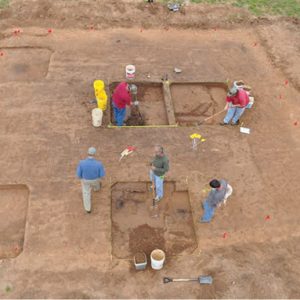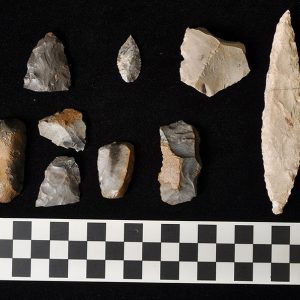calsfoundation@cals.org
Carden Bottom
Carden Bottom (also known as Carden’s Bottom or Carden Bottoms) is a rich alluvial flood plain in northeastern Yell County created by the Arkansas River and internationally known for its rich archaeological heritage. Named for the James Carden family who settled there in the early 1800s, it is bounded by the Petit Jean River and Petit Jean Mountain, Holla Bend National Wildlife Refuge, and the Arkansas River. The area’s farmers produce large crops of sorghum, soybeans, corn, winter wheat, and hay.
Archaeological investigations from the early 1990s indicate that some of these acres were also farmed from 500 to 1,500 years ago by Native Americans (Woodland through Mississippian cultures). A foraging lifeway extended as far back as 11,500 years ago (Dalton through Archaic cultures).
The Late Mississippian pottery vessels of the late prehistoric occupation have made Carden Bottom famous in certain circles as a result of the looting of Native American graves there from as early as the 1870s, though most prominently in the 1920s and 1930s. Dealers such as G. E. Pilquist were happy to supply these pots to collectors and museums eager to acquire them. Neither group apparently expressed concern that perhaps some of the purchased vessels were not actually from Carden Bottom but were instead from other Late Mississippian cemeteries and only given a “Carden Bottom” provenance to increase their marketability. In fact, some of the vessels were outright fakes.
Important collections can be found at the University of Arkansas (UA) in Fayetteville (Washington County), the Gilcrease Institute in Tulsa, Oklahoma, and the Smithsonian Institution in Washington DC. Unfortunately, these pots provide very little substantive data about where Indians lived, how they lived, or even when they lived in Carden Bottom.
The expedition of Hernando de Soto provides some other information on these Mississippian peoples in the Arkansas River Valley. The expedition visited an important capital city, Tanico, in September 1542. Tanico was the capital of the province of Cayas. The inhabitants of Cayas were many, but they apparently lived in scattered settlements. The Spaniards stayed awhile, made salt there with an elaborate filtration process, and eventually headed out for a big battle two days’ march away at Tula with the Caddo. Because the great quantity of pottery looted from graves in Carden Bottom and nearby suggested a large Native American population, it has been convenient to assume that this area could be associated with Tanico. This association suggests that the most recent prehistoric Native American inhabitants of Carden Bottom called themselves the people of Cayas. However, the Cayas still cannot be connected conclusively to a modern group.
In the last two decades, there has been a renewal of scientific interest in the archaeological evidence of Native Americans in Carden Bottom, focused not on pots or burials but on the lifeways of the people of Cayas. In the early 1990s, site survey efforts by the Arkansas Archeological Survey and the Arkansas Archeological Society identified many sites in the area, with particular concern with Late Mississippian sites. Fieldwork has included controlled surface collection, as well as test excavations that found pits full of Native American garbage. This trash included stone tools, discarded animal bones, and broken domestic pottery. Geophysical prospecting in 2009 on one site indicated that there are numerous additional pit features worth exploring. Recent fieldwork and analysis has explored the relationships between the people of Tanico or Carden Bottom and the rock art made by prehistoric Native Americans on nearby Petit Jean Mountain. There are striking similarities between many of the designs found on pottery looted from Carden Bottom and the designs used by prehistoric Indians on Petit Jean.
Finally, it is evident now that thorough analysis of at least one of the trash deposits can illuminate one of the most interesting epochs in Native American history in Arkansas, from the 1500s into the 1600s. Test excavation in 1993 and more work in 2009 have confirmed that the trash deposit, created in an effort to fill in a gulley eroding in the back side of the village, contains the full range of Native American artifacts, as well as glass and brass beads and iron objects that could only have come from encounters with Europeans. The artifacts and other data from the pit document the climax of the Mississippian culture and the beginnings of the contact period. More fieldwork is planned to explore these issues.
For additional information:
Clancy, Phillis Marie. “The Carden’s Bottom Puzzle Elucidated.” MS thesis, University of Arkansas, 1985.
Dickinson, S. D., and S. C. Dellinger. “A Survey of the Historic Earthenware of the Lower Arkansas Valley.” Arkansas Archeological Society Bulletin 4.4 (1963): 9–18.
Harrington, Spencer P. M. “The Looting of Arkansas.” Archaeology 44 (May/June 1991): 22–30.
Hilliard, Jerry E. “History of Archeology in Carden Bottom.” Arkansas Archeological Society Fieldnotes 183 (1981): 3–6.
Hoffman, Michael P. “Ethnic Identities and Cultural Change in the Protohistoric Period of Eastern Arkansas.” In Perspectives on the Southeast: Linguistics, Archaeology, and Ethnohistory, edited by P. B. Kwachka. Southern Anthropological Society Proceedings 27. Athens: University of Georgia Press, 1994.
———. “The Terminal Mississippian Period in the Arkansas River Valley and Quapaw Ethnogenesis.” In Towns and Temples along the Mississippi, edited by David H. Dye and Cheryl Anne Cox. Tuscaloosa: University of Alabama Press, 1990.
Steeno, Gillian Marie. “Household Manifestations of Coalescence at Carden Bottoms (3YE0025) and in the Arkansas River Valley.” MA thesis, University of Arkansas, 2023. Online at https://scholarworks.uark.edu/etd/4916/ (accessed December 1, 2023).
Stewart-Abernathy, Leslie C. “The Carden Bottom Project Gets Underway.” Arkansas Archeological Society Fieldnotes 237 (November/December 1990): 7–8.
———. “The Carden Bottom Project, Yell County, Arkansas: From Dalton to Trade Beads, So Far.” Arkansas Archeological Society Fieldnotes 261 (November/December 1994): 3–7.
Wiewel, Rebecca. “Constructing Community in the Central Arkansas River Valley: Ceramic Compositional Analysis and Collaborative Archaeology.” Ph.D. diss., University of Arkansas, 2014.
Leslie C. Stewart-Abernathy
Arkansas Archeological Survey
 Geography and Geology
Geography and Geology Carden Bottoms Excavations
Carden Bottoms Excavations  Screening for Artifacts
Screening for Artifacts  Stone Tools
Stone Tools 




Comments
No comments on this entry yet.